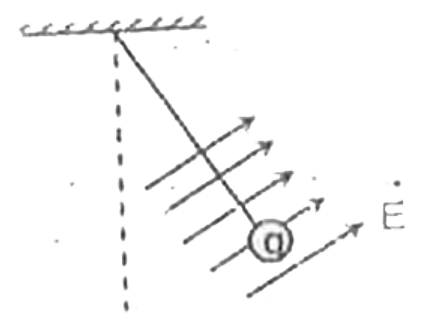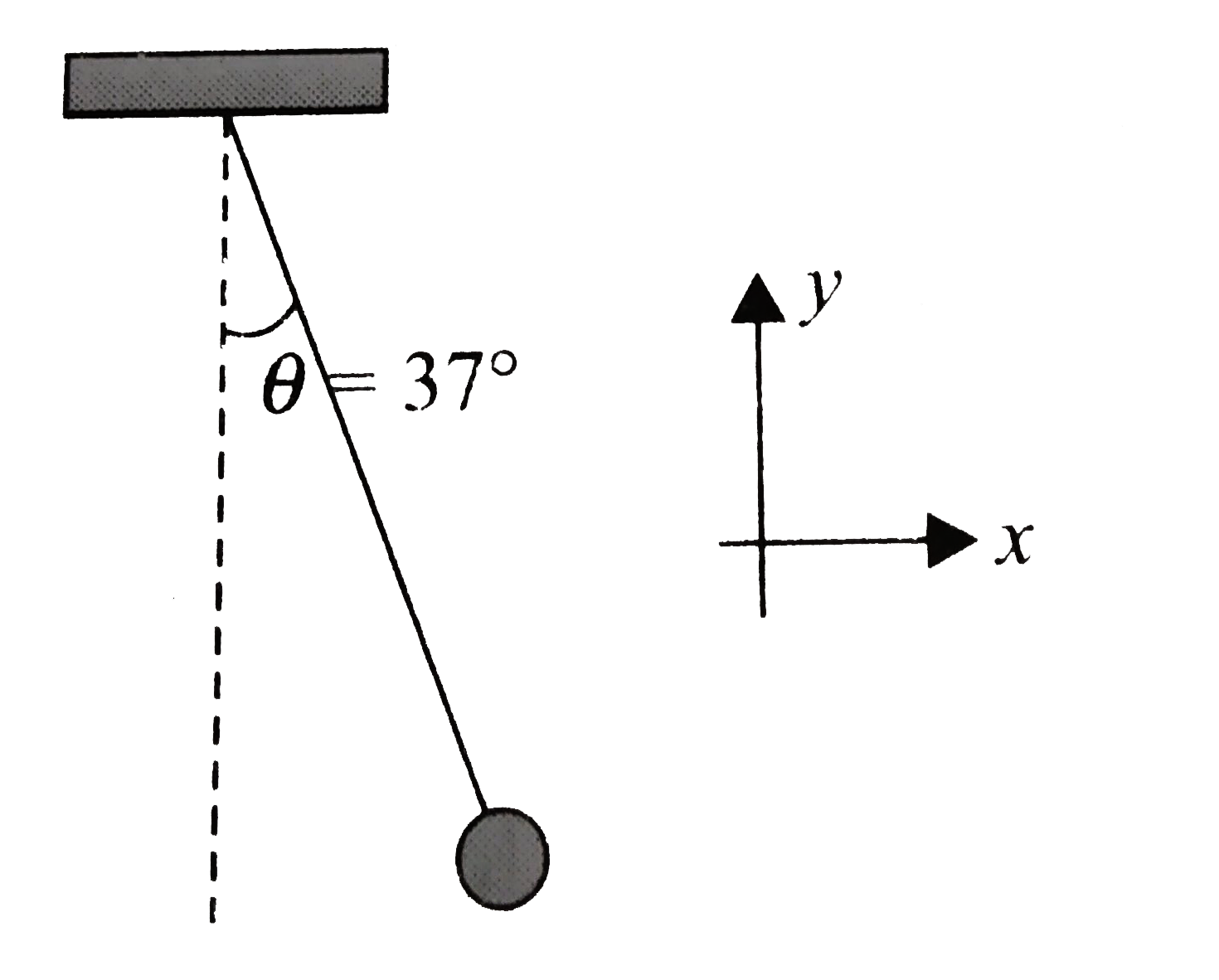(A): A small metal ball is suspended in a uniform electric field with an insulated thread. If high energy X-ray beam falls on the ball, the ball will be deflected in the electric field.
(R ): X-rays emits photoelectron and metal becomes negatively charged.
Both .A. and .R. are true and .R. is the correct explanation of .A.
Both .A. and .R. are tru and .R. is not the correct explanation of .A.
A. is true and .R. is false
A. is false and .R. is true
The correct Answer is:C
To solve the given question, we will analyze both the assertion (A) and the reason (R) step by step.
1. Understanding the Assertion (A):
- The assertion states that a small metal ball suspended in a uniform electric field will be deflected when a high-energy X-ray beam falls on it.
- The ball is suspended with an insulated thread, which means it can move freely without any interference from other forces.
2. Effect of the Electric Field:
- In a uniform electric field, a charged object experiences a force. The direction of this force depends on the sign of the charge.
- The force acting on the ball can be described by the equation F=Q⋅E, where F is the force, Q is the charge on the ball, and E is the electric field strength.
3. Impact of the X-ray Beam:
- When a high-energy X-ray beam strikes the metal ball, it can cause the emission of electrons from the surface of the metal. This phenomenon is known as the photoelectric effect.
- The emitted electrons are referred to as photoelectrons.
4. Charge of the Metal Ball:
- As electrons are ejected from the metal ball due to the X-ray beam, the ball loses negative charge (electrons).
- Consequently, the metal ball becomes positively charged because it has lost negatively charged electrons.
5. Deflection of the Ball:
- Since the ball is now positively charged, it will experience a force in the direction of the electric field.
- Therefore, the ball will be deflected in the electric field due to its positive charge.
6. Understanding the Reason (R):
- The reason states that X-rays emit photoelectrons and that the metal becomes negatively charged.
- However, this statement is incorrect. While X-rays do emit photoelectrons, the metal ball becomes positively charged due to the loss of these electrons, not negatively charged.
7. Conclusion:
- The assertion (A) is true: the ball will be deflected in the electric field.
- The reason (R) is false: the metal ball does not become negatively charged; it becomes positively charged.
Final Answer:
- Assertion (A) is true.
- Reason (R) is false.
- The assertion states that a small metal ball suspended in a uniform electric field will be deflected when a high-energy X-ray beam falls on it.
- The ball is suspended with an insulated thread, which means it can move freely without any interference from other forces.
- In a uniform electric field, a charged object experiences a force. The direction of this force depends on the sign of the charge.
- The force acting on the ball can be described by the equation F=Q⋅E, where F is the force, Q is the charge on the ball, and E is the electric field strength.
- When a high-energy X-ray beam strikes the metal ball, it can cause the emission of electrons from the surface of the metal. This phenomenon is known as the photoelectric effect.
- The emitted electrons are referred to as photoelectrons.
- As electrons are ejected from the metal ball due to the X-ray beam, the ball loses negative charge (electrons).
- Consequently, the metal ball becomes positively charged because it has lost negatively charged electrons.
- Since the ball is now positively charged, it will experience a force in the direction of the electric field.
- Therefore, the ball will be deflected in the electric field due to its positive charge.
- The reason states that X-rays emit photoelectrons and that the metal becomes negatively charged.
- However, this statement is incorrect. While X-rays do emit photoelectrons, the metal ball becomes positively charged due to the loss of these electrons, not negatively charged.
- The assertion (A) is true: the ball will be deflected in the electric field.
- The reason (R) is false: the metal ball does not become negatively charged; it becomes positively charged.
- Assertion (A) is true.
- Reason (R) is false.
Topper's Solved these Questions
- ELECTRIC CHARGES AND FIELDSBOOK - AAKASH SERIESCHAPTER - ELECTRIC CHARGES AND FIELDSEXERCISE - Exercise-II
56 Videos
- ELECTRIC CHARGES AND FIELDSBOOK - AAKASH SERIESCHAPTER - ELECTRIC CHARGES AND FIELDSEXERCISE - Practice Exercise
57 Videos
- ELECTRIC CHARGES AND FIELDSBOOK - AAKASH SERIESCHAPTER - ELECTRIC CHARGES AND FIELDSEXERCISE - Assess Your Self
13 Videos
- DUAL NATURE OF RADIATION AND MATTERBOOK - AAKASH SERIESCHAPTER - DUAL NATURE OF RADIATION AND MATTEREXERCISE - PRACTICE EXERCISEX
42 Videos
- ELECTRIC FIELD AND POTENTIALBOOK - AAKASH SERIESCHAPTER - ELECTRIC FIELD AND POTENTIALEXERCISE - PROBLEMS (LEVEL-II)
26 Videos
Similar Questions
A small metal ball is suspended in a uniform electric field with the help of an insulated thread. If high energy X-ray beam falls on the ball, the ball will be deflected in the direction of the field.
View SolutionA hallow metal sphere of radius R is uniformly charged. The electric field due to the sphere at a distance r from the centre:
View Solution
Knowledge Check
Assertion : 1. In the presence of an electric field, the canal rays are deflected towards the negative electrode.
Reason : Canal rays are composed of electrons which are negatively charged.AIf both Assertion and Reason are correct and Reason is the correct explanation of Assertion.BIf both Assertion and Reason are correct and Reason is not the correct explanation of Assertion.CIf Assertion is correct but Reason is incorrect.DIf Assertion is incorrect but Reason is correct.
Assertion: X-rays cannot be deflected by electric or magnetic fields
. Reason: These are electromagnetic waves.
View SolutionTwo vertical metallic plates carrying equal and opposite charges are kept parallel to each other like a parallel plate capacitor. A small spherical metal ball is suspended by a long insulated thread such that it hangs freely in the centre of the two metallic plates. The ball which is uncharged is taken slowly towards the positively charged plate and is made to touch that plate. Then the ball will
View SolutionA 1kg ball is suspended in a uniform electric field with the help of a string fixed to a point. The ball is given a charge √5 coulomb and the string makes an angle 37∘ with the vertical in equilibrium position. In the equilibrium position the tension is double the weight of the ball. Find the magnitude of the electric field in N/C.
View SolutionFive Styrofoam balls are suspended from insulating threads. Several experiments are performed on the balls and the following observations are made:
(i) Ball A repels C and attracts B.
(ii) Ball D attracts B and has no effect on E.
(iii) A negatively charged rod attracts both A and E.
An electrically neutral Styrofoam ball gets attracted if placed nearby a charged body due to induced charge. What are the charges, if any, on each ball A,B,C,D, and E?
View SolutionAn uncharged metal sphere suspended by a silk thread is placed in a uniform extermal electric field. E. (a) what is the magnitude of the electric field for points inside the sphere ? (b) is your answer changed if the sphere carriers a charge ?
View SolutionA charged cork ball having mass of 1 gram and charge q is suspended on a light string in a uniform electric field as shown in the figure. The ball is in equilibrium at 0=37∘, when value of electric field is →E=(3ˆi+5ˆj)×105N/C. Assume T as tension in the string. Which of the following options are correct? (Given sin37∘=0.60andg=10m/s2)

View SolutionA charged ball of mass 9 kg is suspended from a string in a uniform elelctric field →E=(3ˆi+5ˆj)×105N/C. The ball is in equilibrium with θ=37∘. If direction of electric field is reversed, find the new equilibrium position of the ball. Given your answer in terms of angle made by string with vertical. Take g=10ms−2.

View Solution
